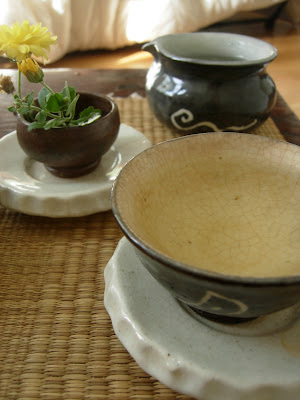


One wrote this post up in the early fall of 2009 but never published it. After reading a nice post of the 2010 Jung Jak grade on Potery of Tea one decided to publish this as a reference.
Let's go back... and sit down on a sunny fall day with this green...
After sheding the four levels of packaging, the goods are revealed. The dry leaves are a beautiful vibrant green with a hue of blue running through them. They smell of evergreens and nuts under the soft, smooth, roasted notes- the scent of this tea is as delicate as its leaves. As the boiling water cools one meditates on these leaves and clears the mind.
The first infusion is prepared. There is fresh depth to this tea as well as a fair bit of green tea complexity. Things are light, watery, grassy with fishy, roasted notes.

The second infusion is light and tangy and stimulates the whole mouth with a silky feel. Roasted, fresh, sea-salted green notes are enjoyed.
In the third infusion the flavour is more roasted and fills the whole mouth. The chaqi is clean, alerting, and clear.
The fourth infusion dries the lips and the front of the tongue. Light, roasted notes are still present but tones of hay start to emerge.

The fifth feels quite round and complete in the mouth in flavour and feel. Lower notes like pine tree and dirt harmonize with lighter notes in this infusion.
The sixth has a nice full taste and feel as well but a certain blandness is becoming evident. The seventh, eighth, and ninth infusions are watery, thin, gritty and dry. Some fishy & buttery notes are picked out.

The wet leaves show a nice mix of buds and small leaves.
Peace


7 comments:
The way this tea is packed... it once again shows the respect and deep reverence of Koreans to tea.
I love the way they, along with Japanese, pack most of their teas; it's always pleasure opening a shipment with teas like this when you can see that already the package is art by itself.
This is, in my opinion, another of thousands things we, Europeans (and most probably Americans, too) should learn from advanced Asian nations like Korea and Japan. This kind of esteem towards... goods this good.
Thanks for another great post and beautiful photos.
Michal,
Tea packaging in Korea and Japan is about two things.
First, as you mentioned, is about reverence and respect for good things. With tea, as with clothes and high end herbs, very good packaging is a must. This is especially true if the product is a gift. Because good quality Korean green tea is very expensive in Korea, it would be extremely rare for a Korean to drink daily. Teas like this that sell for about $40.00 per 80 grams in Korea are generally drank for special occasions or given as gifts. You always want to give pretty gifts.
Second, packaging is about marketing. 99.999 % of the Korean population doesn't know what real good quality tea is so often they just buy the prettiest packaging. It is a commonly held belief that the prettiest package will contain the highest quality goods. Producers often play on this by offering the more extravagant packaging for their highest quality items.
Jookro also plays this game- see how this 2007 Premium First Day Ujeon ($120.00 US for 90 grams) is extravagantly packaged:
http://mattchasblog.blogspot.com/2008/08/its-whats-inside-that-counts-2007.html
Peace
Yes, that's another thing - but still, even if you look at packages of most of their cheaper teas, they look much better than in what you get tea around here in most cases.
Just for example - few months ago, I got, along with other things, a simple, cheap gift from a friend who went to Japan in that time - it was a Bancha tea, the cost of which was just about 3 Euro for 50 grams. Still, the package is very elegant and beautiful, just as I would expect from tea of much higher grade.
On the other hand, when I buy tea here, even tea of very high quality, if it isn't in original packaging in which it was imported from Asia, I'm really lucky to get it in a simple zip lock bag.
I know this isn't important and doesn't influence the quality of tea, but still... I can't help myself not to admire Japanese and Koreans for this kind of packages.
By the way, the package of that 2007 Premium First Day Ujeon reminds me of this - http://www.e-tea.eu/resize/domain/tea/files/prod-caj-japan/maruyama/chasimeijin/chasimeijin-2.jpg?w=1024&h=768
this is one really good Sencha from Shizuoka and another great example how extravagant package helps to sell high quality tea.
Michal,
The packaging of tea in Korea & Japan is definitely an art.
In ones experience, if tea is packaged in wood box, it is likely the highest quality that the producer offers. Wooden boxes aren't cheap packaging and are kind of a throw back to tea produced long ago.
Unfortunately there is the environmental impact of such over-the-top packaging.
Peace
Funny -- I bought a pack of this at the HK tea expo. Will try it soon.
MarshalN,
Were there representatives from Jookro at the HK tea festival or just a dealer selling some different Korean teas?
You'll have to let us know what you think of one of the oldest and most reputable tea producers in Korea.
Peace
The owner was there -- he's a youngish man, it seems, a true believer.
Post a Comment